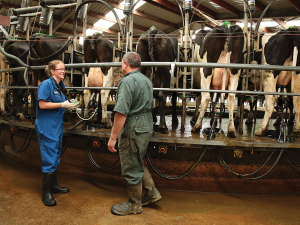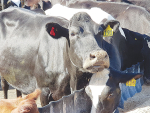The lactation period runs from two
weeks after calving until
drying off.
Cows are at risk
of new infections
from contagious or
environmental bacteria at
every milking during this
time.
An effective mastitis
prevention programme
will ensure more milk in
the vat, less risk of milk
penalties, less use of
antibiotics and more time
saved.
Bacteria in milk from
infected quarters may
contaminate the skin of
many other teats during
milking.
For example, after
a liner has milked an
infected quarter, bacteria
may be transferred to the
next 5-6 cows milked with
that cup. After milking,
bacteria multiply on the
teat skin and may extend into the teat canal.
If the whole surface
of each teat is disinfected
immediately after
milking, this spread
can be minimised. Teat
disinfection also helps to keep teat skin supple and
healthy. Teat disinfection
after milking reduces new
infections due to cowassociated
bacteria such
as Staph. aureus by 50%
and is also important in
reducing Strep. uberis
infections. It is one of the
most effective cell count
and mastitis control
measures available, but
it only works if it is done
thoroughly.
Teat disinfectants must
be diluted to the correct
concentration for use.
The active ingredients
often lose their
disinfectant ability with
time after mixing, and if
you include additives to
improve skin condition
(emollients) these may
reduce disinfectant
activity.
Any contamination
with milk and other
organic material also
reduces activity. Correct
mixing each day is
best to get maximum
performance. Some
emollients are not
suitable for use with
particular disinfectants.
Failure to cover the whole
teat of every cow at
every milking and poorly
diluted teat sprays are the
most common errors in
teat disinfection.
Milking machines
Milking machine
equipment has been
designed to harvest milk
efficiently and maintain
healthy teats. Teats are
attached to milking
machines for 50-100
hours per lactation.
Machines that are not
functioning correctly can
contribute to new mastitis
infections by:
- Spreading bacteria
from teat to teat and
from cow to cow
- Damaging the teat
ends and natural
defence mechanisms of
the teat canal
- Causing impact of
bacteria-laden droplets
into the teat canal,
especially towards the
end of milking
- Reducing the degree or
frequency of full udder
milk-out
The most common
reason for milking
machine problems is
inadequate routine
maintenance of
mechanical components
and rubberware.
A series of regular,
systematic checks gives a
simple method of finding
problems and guiding
preventative maintenance.
If more than one person
milks in your dairy, it
is important to assign
these checks to particular
people, and ensure that
the right person is alerted
to any problems that are
found or suspected.
Daily and weekly
checks should be
conducted by milking staff
as part of their regular list
of responsibilities.
Monthly checks
should be done by the
herd owner or manager
or other skilled observer.
Recording the results of
monthly checks enables
subtle changes due
to wear and age to be
detected more easily.
Bacteria are present
in milk from all infected
quarters.
They are spread to
other quarters and cows
by splashes or aerosols
of milk that occur during
stripping, by milkers’
hands, teatcup liners
and by cross flow of
milk between teatcups.
Keeping hands and
the milking area under
the cows as free as
possible from dirt and
contaminated milk will
help to reduce the risk of
transferring bacteria from
cow to cow.
Low pressure, high
volume washing water
should be used to sluice
away manure. High
pressure hoses should not
be used directly beneath
or around cows, as these
can create aerosols of
bacteria-laden droplets
to form and settle onto
cows. Clinical cases and
chronically infected cows
are a source of infection
for healthy, young cows.
If these mastitis cows
are milked last, the risk
of spreading infection is
markedly reduced.
Wearing Gloves
Gloves should always be used,
especially when searching for
or dealing with clinical cases of
mastitis.
A bare hand is more difficult to
clean and disinfect during milking,
than a gloved hand. Gloves also
protect hands from the drying
effects of dirt, water and manure.
Try to keep gloves clean during
milking - rinse off dirt regularly and
disinfect after stripping a clinical
case. Change them if they become
torn, and replace gloves after
each milking.
Gloves, liners and equipment
used to milk clinical cases will
become contaminated with
bacteria. Rinsing with running
water for about 30 seconds
provides a physical wash.
Dipping in a disinfectant
solution, such as 1% iodophor
or 0.02% available chlorine,
provides a sanitising effect. Any
physical rubbing or drying with
a paper towel can speed up the
rinsing/disinfectant process. Teat
disinfectants are not generally
recommended to disinfect
hands or equipment, as they are
formulated for a prolonged contact
time.


















